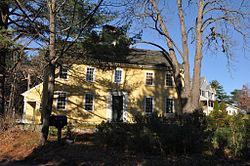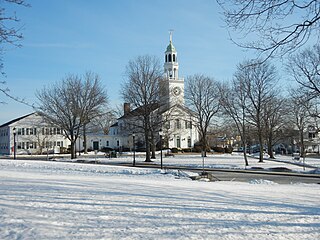
Reading is a town in Middlesex County, Massachusetts, United States, 16 miles (26 km) north of central Boston. The population was 25,518 at the 2020 census.

Buckman Tavern is a historic American Revolutionary War site associated with the revolution's very first battle, the 1775 Battle of Lexington and Concord. It is located on the Battle Green in Lexington, Massachusetts and operated as a museum by the Lexington Historical Society.

The Peirce–Nichols House is a historic house museum located at 80 Federal Street in Salem, Massachusetts. Designed early in the career of noted Salem builder Samuel McIntire (1757–1811), and modified later by him, the building gives a unique view into the methods and styles of McIntire. It was designated a National Historic Landmark in 1973 for its significance as an early masterwork of one of the country's first recognized master builders. It is now owned by the Peabody Essex Museum.

The Lexington Battle Green, also known as Lexington Common, is the historic town common of Lexington, Massachusetts, United States. It was at this site that the opening shots of the Battles of Lexington and Concord were fired on April 19, 1775, starting the American Revolutionary War. Now a public park, the common is a National Historic Landmark.

The Concord Monument Square–Lexington Road Historic District is an historic district in Concord, Massachusetts. Monument Square, at the center of the district, was laid out in 1635. The district includes a collection of well-preserved residential houses stretching along Lexington Street southeast from the square, and along Lowell northwest of the square. The square is prominently known as the site of British activities on April 19, 1775, the day of the Battles of Lexington and Concord which began the American Revolutionary War, and of earlier meetings by Massachusetts Patriots which were held in the First Parish Church and Wright's Tavern. The Tavern and the Ralph Waldo Emerson House, which stands near the eastern end of the district, are both National Historic Landmarks. The district was listed on the National Register of Historic Places in 1977.

The Black Tavern is an historic tavern at 138-142 Dudley Center Road in Dudley, Massachusetts. The main block of the tavern was built c. 1803, and is one of the town's finest examples of Federal period architecture. It originally housed a major stop on the stagecoach route between Boston, Massachusetts and Hartford, Connecticut. It is now maintained by a local preservation organization, and was listed on the National Register of Historic Places in 1985. In 2010 the listing was expanded to include the adjacent barn and annex, which the society acquired in 2000.
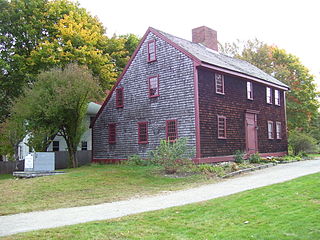
The Parker Tavern is a historic house museum in Reading, Massachusetts, United States. Built in 1694, it is the oldest extant structure in Reading. The saltbox was built by Abraham Bryant, a farmer and blacksmith, and Ephraim Parker operated a tavern on the premises in the 18th century. It has been a local history museum since 1923, and was listed on the National Register of Historic Places in 1975.

The Col. Benjamin Simonds House is a historic house at 643 Simonds Road in Williamstown, Massachusetts. The colonial style wood-frame house was built in 1770 by Benjamin Simonds, a veteran of the French and Indian Wars, who was one of Williamstown's early settlers. The house was listed on the National Register of Historic Places in 1983, and now houses a bed and breakfast.

The Boston Post Road Historic District encompasses a portion of the historic roadway known as the Boston Post Road, which ran Boston, Massachusetts to Albany, New York. The surviving alignment in Weston, Massachusetts extends along the entire length of United States Route 20, except for a bypassed section that passes through the town's village center. The 3.5 miles (5.6 km) of roadway retains much of the generally rural appearance it had during the late colonial period, and the town center retains significant elements of historic character as well. The district was added to the National Register of Historic Places in 1983.

The Harnden Tavern, also known as the Col. Joshua Harnden Tavern, is a historic tavern that was built in 1770 at 430 Salem Street in Wilmington, Massachusetts.
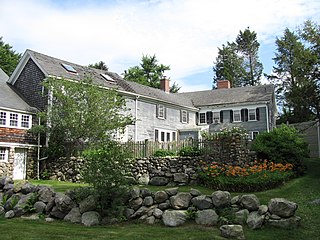
Hoar Tavern, or the Hoar Homestead, is a historic tavern and house northeast of downtown Lincoln on Reiling Pond Road in Lincoln, Massachusetts. With a construction history dating to 1680, it was for nearly two centuries home to the Hoar family, a prominent legal and political family in Massachusetts. It was listed on the National Register of Historic Places in 1973.

The Brackett House is a historic house in Reading, Massachusetts. Built during a local residential construction boom in 1920, it is Reading's best example of Bungalow style architecture. It was listed on the National Register of Historic Places in 1984.

The Capt. Nathaniel Parker Red House is a historic house at 77–83 Ash Street in Reading, Massachusetts. It is a 2+1⁄2-story vernacular Georgian house, five bays wide, with entrances on its north and south facades. The southern entry is slightly more elegant, with flanking pilasters and a transom window. The house was built sometime before 1755, and was already a well-known landmark because it was painted, and served as a tavern on the coach road. The Tavern served as a meeting place for many revolutionaries and minute men, notably Marquis de Lafayette, and Alexander Hamilton. The house remained in the hands of militia captain Nathaniel Parker and his descendants into the late 19th century. The construction of the Andover Turnpike in 1806–07, bypassing its location, prompted a decline in the tavern's business.

The Daniel Nichols Homestead is a historic home in Reading, Massachusetts. The oldest portion of this timber-frame house was built in the early 1740, with vernacular Georgian styling. The house is five bays wide and two deep, with a rear shed-roof extension giving the house a saltbox appearance. An ell was added in the mid-19th century. The main architectural detail is the front door surround, which features sidelight windows and recessed, paneled pilasters supporting a tall entablature.
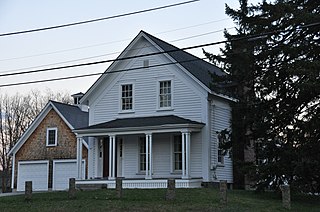
1177 Main Street in Reading, Massachusetts, is a well-preserved and prominent local example of transitional Greek Revival-Italianate house. It was built sometime before 1854 by John Nichols, and probably served as a farmhouse. It was listed on the National Register of Historic Places in 1984.

The James Nichols House is a historic house in Reading, Massachusetts. Built c. 1795, this 1+1⁄2-story gambrel-roofed house is built in a vernacular Georgian style, and is a rare local example of the style. The house was built by a local shoemaker and farmer who was involved in a religious dispute that divided the town. The house was listed on the National Register of Historic Places in 1984.

The Richard Nichols House is a historic late First Period house at 483 Franklin Street in Reading, Massachusetts, United States. It is a 2+1⁄2-story wood-frame structure, six bays wide, with a side-gable roof, clapboard siding, rubblestone foundation, and an entry in the third bay from the left, with a chimney behind. The oldest portion of this house, probably a three-bay section with chimney, was built c. 1733, and expanded to five, and then six, bays later in the 18th century. The house, along with extensive landholdings, remained in the locally prominent Nichols family until the late 19th century.
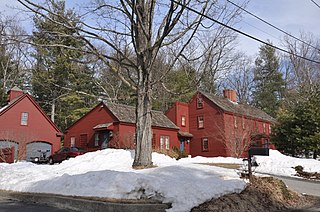
The Samuel Foster House is a historic house in Reading, Massachusetts.
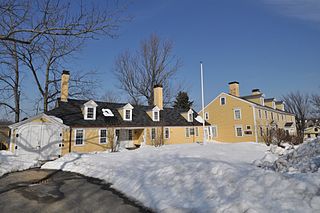
The American Independence Museum is a historic house museum located in Exeter, New Hampshire. Its 1-acre (0.40 ha) campus includes two buildings: the Ladd-Gilman House, a registered National Historic Landmark built in 1721 by Nathaniel Ladd, and the Folsom Tavern, listed on the New Hampshire State Register of Historic Places and built in 1775 by Colonel Samuel Folsom. The museum was opened in 1991 after a rare copy of the Declaration of Independence known as a Dunlap Broadside was found in the Ladd-Gilman house, 200 years after its arrival in Exeter. It is the centerpiece of the museum’s collection. The museum’s mission is “Connecting America’s Revolutionary past with the present.”

The Dudley Hill Historic District encompasses the historic heart of Dudley, Massachusetts. The historic district is essentially linear, extending along Center Street between Dudley Hill and Tanyard Roads. This area was the first to be settled in the mid-17th century, and is composed mainly of civic, religious, and residential buildings dating to the 18th and 19th centuries. The district listed on the National Register of Historic Places in 2001.
